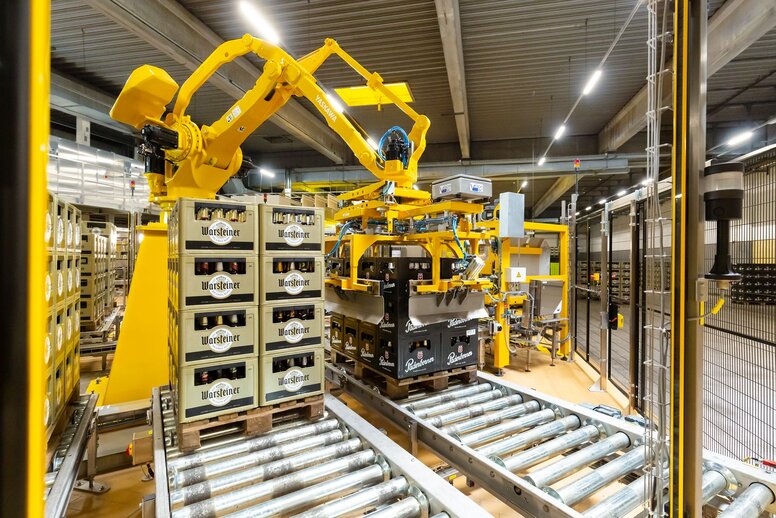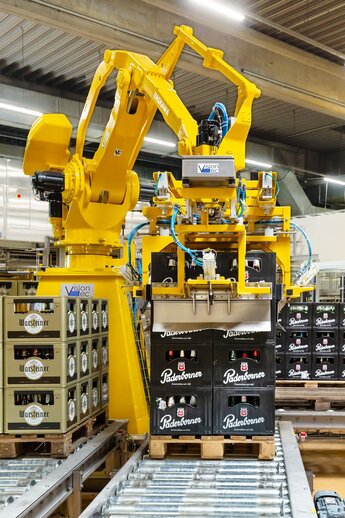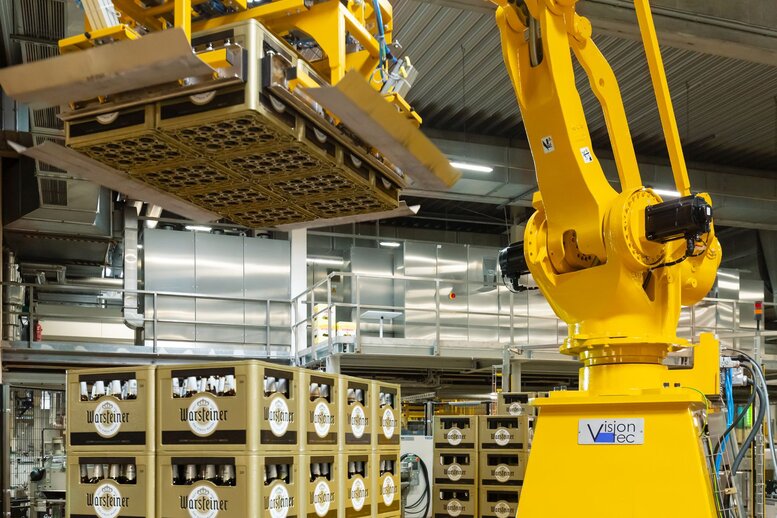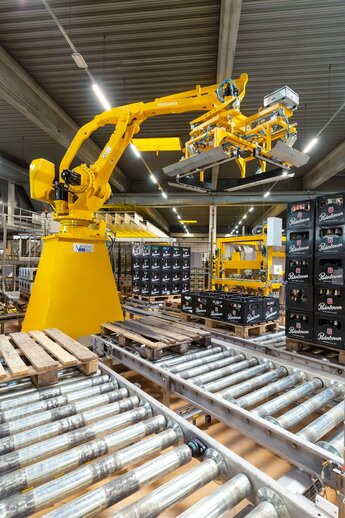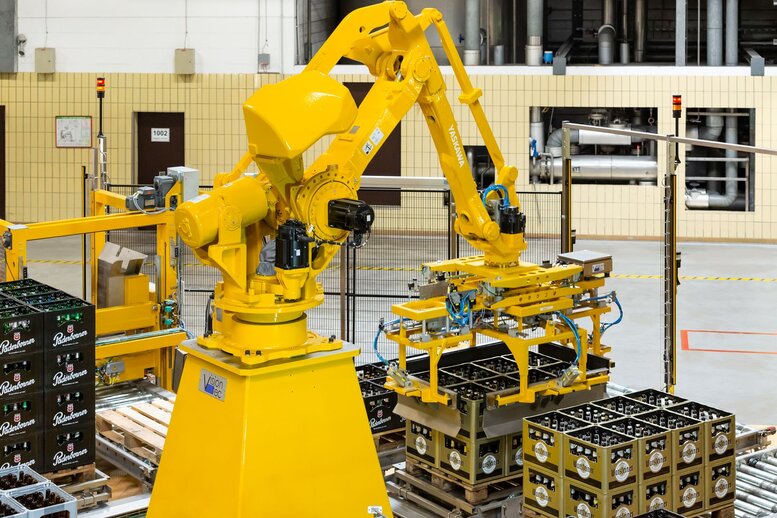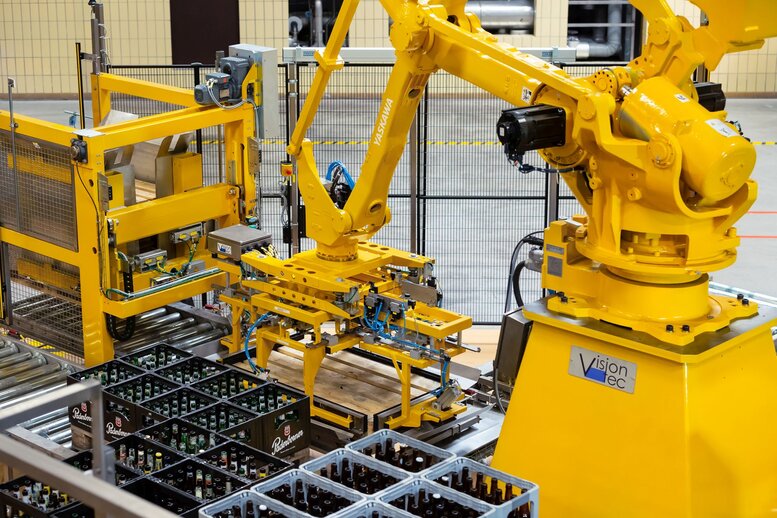De hoogste kwaliteit in combinatie met uitstekende prestaties heeft een naam: MOTOMAN
Robot-based empties handling at the Paderborner brewery
- Industrieën
- Levensmiddelen & dranken
- Toepassingen
- Pick & Place
- Handling
- Palletiseren
- Klant
- vision-tec GmbH
Bottles up!
Individual packaging is in vogue – in the brewing industry, too. For automated empties handling, however, this diversity means demanding requirements that are often newly introduced. As shown by a current project being run by system solution provider vision-tec gmbh, jointed-arm robots offer great potential: At the Paderborner brewery, a Motoman industrial robot by Yaskawa tackles complex tasks in the same-type palletising of third-party empties.
The Challenge
Even though the returnable beverage packaging quota has been decreasing for years, refillable bottles and crates are still in demand – especially in the brewing industry. And not just that: for many breweries, it is even worth sorting the empties of other brands according to type in order to later exchange them with their colleagues for their own empties.
This also applies to a large extent to the Paderborner brewery. It has been part of the Warsteiner Group since 1990. However, the tradition of the modern brewery dates back to 1852. Today, around 98 per cent of the beverages produced there is filled into reusable containers. The entire handling of empties also takes place in the immediate vicinity of the filling plants. “Whereas in the past the proportion of other-brand empties was about five per cent, today it accounts for more than a third,” says Uwe Bernardy, who is in charge of the bottling department at the Paderborner brewery. And he also states the reason for this development: the increasing individualisation of bottles and crates.
Currently, seven types of third-party empties are regularly prepared for transport on pallets. If this were sorted by hand today, 15 to 20 employees would have to do the job – a physically strenuous task which, in addition, no longer matches the generally high degree of automation of the filling line. After all, the Paderborner brewery was one of the first breweries in the world to use robots for the automatic sorting of bottles, having started in 2003.
Assignment: flexibility within a small space
In view of this background, the aim was to completely automate this stage of the process as well. After looking at several concepts for the implementation of a complete sorting and repackaging system for up to seven crates and bottles, vision-tec gmbh in Kassel was chosen as the solution provider. Founded as a planning office in August 2011, the company is now the market leader for automatic empty container sorting systems. The portfolio includes patented recognition and sorting machines for the beverage and food industry as well as complete system planning.
For vision-tec it was not the first order from the Paderborner brewery. In fact the Kassel-based specialists have implemented several automation projects on the filling line there in recent years. For example, in 2014 the sorting plant was equipped with one of the latest vision-tec sorting robots, which has since set new standards in sorting quality and performance as well as plant flexibility.
Flexibility was also one of the central requirements for the current task. Above all, however, the aim was to ensure this flexibility within the smallest possible area and at high cycle rates. In addition, the system had to be largely maintenance-free and of course offer a sound cost-benefit ratio.
Plant layout: the robot is located at the centre
When designing the system, vision-tec's engineers quickly realised that the various requirements could best be met with a jointed-arm robot. “This was a new approach for us, because so far we have always been able to solve all tasks well with portal robots,” says Knut Oppermann, Managing Director and shareholder of vision-tec. "But a jointed-arm robot was the better solution – mainly for reasons of space, but also for reasons of performance.”
The robot is – literally – at the centre of the system: eight palletising positions are arranged in a star shape around the manipulator, which the robot processes with a total output of 1,000 crates per hour. The various other-brand varieties are palletised in layers at six positions. One layer consists of eight boxes. The flexibility of the system is demonstrated by the fact that the pallets can vary between four and six layers depending on the height of the crates or the truck for which they are intended. The seventh position is used – as an additional task between the palletising processes – for depalletising empty crates for the parallel repacking system. And the entire empty pallet handling process is dealt with via the eighth position.
All eight palletising stations each have two pallet positions: a loading position for palletising the crates and a pick-up position for picking up the finished pallet. While a finished pallet is waiting for collection in the pick-up position, the next empty pallet is already positioned in the loading position and can be loaded with further crates of the same type. This avoids waiting times in palletising.
The material is fed directly from the upstream sorting plant. Before palletising, the crates to be palletised are collected in short dust tracks that can hold 16 crates of one sort. The crates are then removed in layers of eight crates from the dust tracks and transported to the palletising robot. A single driverless transport system (AGV) with lithium-ion battery takes care of all transport tasks – from handling the empty pallet stacks and delivering crates for the repacking system to picking up finished pallets – while the system is in operation, saving both space and costs.
MOTOMAN MPL500 II palletising robot by Yaskawa
In the search for a suitable robot, Knut Oppermann and his team opted for a MOTOMAN MPL500 II by YASKAWA, which is equipped with a parallel gripper. “This was not least due to the Motoman robot's good reputation in the beverage sector,” explains Oppermann.
With a vertical reach of 3,024 mm and a horizontal reach of 3,159 mm, the 4-axle truck moves high-precision loads of up to 500 kg. This makes the MPL series model ideal for this type of palletising application. Other key factors here are the model's fast acceleration, a repeat accuracy of 0.5 mm and the high speed of up to 1,200 of the usual palletising cycles per hour. In addition to box and carton palletising, the MOTOMAN MPL500 II can also be used, for example, to implement automation solutions at shipping centres. The internal cable routing from the base to the U-axis ensures high reliability and low interference contours and is also particularly economical. At the request of the brewery to achieve visual standardisation with the other automation components in filling, the robot was given a special yellow paint finish.
In addition to the powerful hardware, another crucial factor in favour of the MOTOMAN MPL500 II robot was that the powerful palletiser uses the current generation of MOTOMAN DX200 controller. The integrated safety controller also makes this high-performance controller a complete Category 3 Functional Safety Controller (FSU). Up to 32 definable safety zones and 16 possible tools enable smaller work areas and optimum utilisation of the production area. “We were able to incorporate these functions into our safety concept without any problem,” says Oppermann.
Via a MotoLogix interface, the robot controller is also integrated into the system software via Ethernet, a PC-based control system with a Windows interface. The networking of all system components enables remote maintenance access to the individual systems in order to be able to help quickly and effectively around the clock in the event of faults.
Conclusion and practical experience
The Paderborner brewery is continuing automation of its bottling line with a complete sorting and repacking system for third-party empties implemented by vision-tec. The innovative use of a Motoman jointed-arm robot is the centrepiece of this solution.
After its first year in practical operation, vision-tec Managing Director Knut Oppermann draws a positive conclusion on all fronts: “Even the commissioning of the Motoman robot was simple. Since then, the system has been running well and absolutely trouble-free.” Oppermann's customer Uwe Bernardy also confirms this impression: “The expectations of the robot have been completely fulfilled!”




















